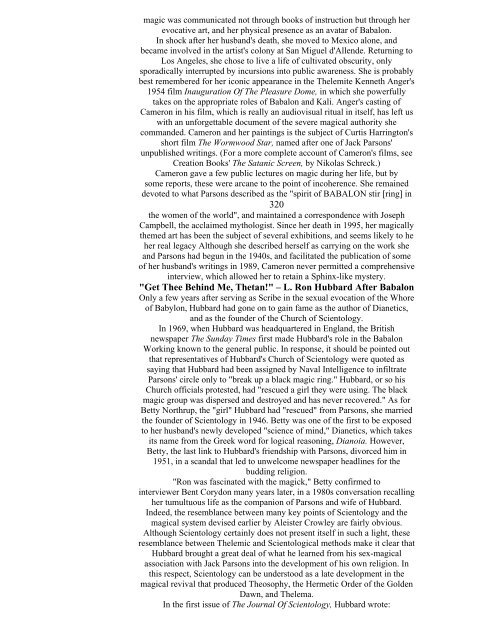I. VAMA MARGA Foundations Of The Left-Hand Path - staticfly.net
I. VAMA MARGA Foundations Of The Left-Hand Path - staticfly.net
I. VAMA MARGA Foundations Of The Left-Hand Path - staticfly.net
You also want an ePaper? Increase the reach of your titles
YUMPU automatically turns print PDFs into web optimized ePapers that Google loves.
magic was communicated not through books of instruction but through her<br />
evocative art, and her physical presence as an avatar of Babalon.<br />
In shock after her husband's death, she moved to Mexico alone, and<br />
became involved in the artist's colony at San Miguel d'Allende. Returning to<br />
Los Angeles, she chose to live a life of cultivated obscurity, only<br />
sporadically interrupted by incursions into public awareness. She is probably<br />
best remembered for her iconic appearance in the <strong>The</strong>lemite Ken<strong>net</strong>h Anger's<br />
1954 film Inauguration <strong>Of</strong> <strong>The</strong> Pleasure Dome, in which she powerfully<br />
takes on the appropriate roles of Babalon and Kali. Anger's casting of<br />
Cameron in his film, which is really an audiovisual ritual in itself, has left us<br />
with an unforgettable document of the severe magical authority she<br />
commanded. Cameron and her paintings is the subject of Curtis Harrington's<br />
short film <strong>The</strong> Wormwood Star, named after one of Jack Parsons'<br />
unpublished writings. (For a more complete account of Cameron's films, see<br />
Creation Books' <strong>The</strong> Satanic Screen, by Nikolas Schreck.)<br />
Cameron gave a few public lectures on magic during her life, but by<br />
some reports, these were arcane to the point of incoherence. She remained<br />
devoted to what Parsons described as the "spirit of BABALON stir [ring] in<br />
320<br />
the women of the world", and maintained a correspondence with Joseph<br />
Campbell, the acclaimed mythologist. Since her death in 1995, her magically<br />
themed art has been the subject of several exhibitions, and seems likely to he<br />
her real legacy Although she described herself as carrying on the work she<br />
and Parsons had begun in the 1940s, and facilitated the publication of some<br />
of her husband's writings in 1989, Cameron never permitted a comprehensive<br />
interview, which allowed her to retain a Sphinx-like mystery.<br />
"Get <strong>The</strong>e Behind Me, <strong>The</strong>tan!" – L. Ron Hubbard After Babalon<br />
Only a few years after serving as Scribe in the sexual evocation of the Whore<br />
of Babylon, Hubbard had gone on to gain fame as the author of Dia<strong>net</strong>ics,<br />
and as the founder of the Church of Scientology.<br />
In 1969, when Hubbard was headquartered in England, the British<br />
newspaper <strong>The</strong> Sunday Times first made Hubbard's role in the Babalon<br />
Working known to the general public. In response, it should be pointed out<br />
that representatives of Hubbard's Church of Scientology were quoted as<br />
saying that Hubbard had been assigned by Naval Intelligence to infiltrate<br />
Parsons' circle only to "break up a black magic ring." Hubbard, or so his<br />
Church officials protested, had "rescued a girl they were using. <strong>The</strong> black<br />
magic group was dispersed and destroyed and has never recovered." As for<br />
Betty Northrup, the "girl" Hubbard had "rescued" from Parsons, she married<br />
the founder of Scientology in 1946. Betty was one of the first to be exposed<br />
to her husband's newly developed "science of mind," Dia<strong>net</strong>ics, which takes<br />
its name from the Greek word for logical reasoning, Dianoia. However,<br />
Betty, the last link to Hubbard's friendship with Parsons, divorced him in<br />
1951, in a scandal that led to unwelcome newspaper headlines for the<br />
budding religion.<br />
"Ron was fascinated with the magick," Betty confirmed to<br />
interviewer Bent Corydon many years later, in a 1980s conversation recalling<br />
her tumultuous life as the companion of Parsons and wife of Hubbard.<br />
Indeed, the resemblance between many key points of Scientology and the<br />
magical system devised earlier by Aleister Crowley are fairly obvious.<br />
Although Scientology certainly does not present itself in such a light, these<br />
resemblance between <strong>The</strong>lemic and Scientological methods make it clear that<br />
Hubbard brought a great deal of what he learned from his sex-magical<br />
association with Jack Parsons into the development of his own religion. In<br />
this respect, Scientology can be understood as a late development in the<br />
magical revival that produced <strong>The</strong>osophy, the Hermetic Order of the Golden<br />
Dawn, and <strong>The</strong>lema.<br />
In the first issue of <strong>The</strong> Journal <strong>Of</strong> Scientology, Hubbard wrote:
















